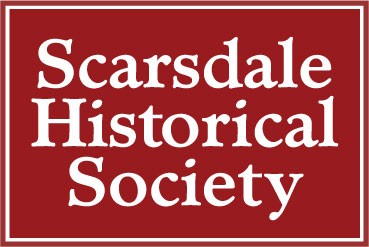Quakers in Scarsdale
The 1828 Quaker Meeting House has given visual recognition to a barely noticed piece of Scarsdale’s early history. Members of the Religious Society of Friends were among the very first white settlers of Scarsdale in 1723 when John Cornwall (an early version of the Cornell name) started farming on some of the land he bought ten years earlier from a fellow Quaker, Samuel Palmer of Mamaroneck. The Quakers put up the first house of worship in Scarsdale in 1768 when they moved the Mamaroneck meeting house they had built in 1739 on the Westchester Path, now the Boston Post Road, to a wooded lot on Weaver Street at Quaker Ridge Road.
Detail from a 1910 map, showing the location of the Quaker Meeting House.
At the time, there were more Quakers living in the Quaker Ridge area than in Mamaroneck. For a period, Quakers predominated in this north/south corridor between the Hudson River and Connecticut, after settling Quaker Ridge in Westchester moving north through Putnam County onto Quaker Hill in Dutchess County, and up the “Oblong” into the lower Berkshires.
About one-third of colonial Scarsdale was a Quaker community, where hard-working farmers raised their families in the eastern half of the town. They came together on First Days (Sundays) and at midweek for worship, and once a month to prepare for their business meetings. In their capacity as a preparative meeting for Purchase Monthly Meeting, they raised 60 pounds in 1814 to build a school at Quaker Ridge Road and Weaver Skeet. This school, open to all children, was the first school in the area for the children of Scarsdale, Mamaroneck and New Rochelle.
Although the lives they led were peaceful and industrious, Scarsdale Quakers participated in world events in their own way. Like the homes of all Westchester County householders, theirs lay open to the “cowboy’” and “skinner” vandals from both sides of the Revolutionary War, but they pleased neither side by refusing to help either the British or the Rebels. Both Purchase and Chappaqua meeting houses were commandeered as hospitals. All suffered losses as a result of seizures for military taxes, requisitions by the armies and property taken by robbers. Heavy financial losses were felt by those who followed Quaker testimonies against war profiteering, and many did not accept the opportunity to buy lands they had lived on and improved for generations as tenants, when Loyalists’ estates were confiscated and sold.
The well-known Quaker crusader for women’s rights, Lucretia Mott, spent six months of 1814 in Mamaroneck with the family of her husband’s uncle, Richard Mott, during which time her son Thomas was born. Another crusader, Susan B. Anthony, attended Mamaroneck Preparative Meeting, while teaching in New Rochelle.
Friends are known for their stand to abolish slavery but some Griffens and Cornells in Scarsdale owned slaves. The Quaker reform movement that swept the country in 1755 encouraged the anti-slavery movement, and encouraged all Friends to free their slaves. In 1774 it became a requirement of membership for Friends to free all slaves at their age of majority, 18 for women, 21 for men.
By 1782 nearly all slaves owned by New York Quakers had been given manumission papers. Quakers also required themselves to train their former slaves to earn a living and to find a place to live. In West Harrison, land was set aside for a settlement called The Hills, which thrived until about 1940 housing as many as 100 people.
Daniel D. Tompkins of Scarsdale, while not a Quaker, had cousins and forebears who were, so it can be assumed safely that he was influenced by them. At the start of his vice-presidential term in 1817, the former New York governor sent a message to the state legislature in Albany advocating the abolition of slavery; the legislature responded by voting to end slavery at the end of ten years.
Westchester Quakers were active in the Underground Railroad. Scarsdale stories tell of slaves hidden in barns and in secret cupboards on Mamaroneck Road. Joseph Carpenter, who lived just over the border in New Rochelle off Weaver Street, was a renowned friend of fugitive slaves. He gave some of his property on Stratton Road in New Rochelle for a cemetery where freed slaves could be buried, which is where he and his wife are both buried.
In the mid-nineteenth century after the railroad came, many large plots of land were sold. Gradually the farmers sold their land and their houses, and in 1911, their meeting houses. Remaining Friends went to Purchase Meeting for worship.
In 1942 when wartime gas rationing made travel difficult, Scarsdale Friends Charles and Ruth Brinton Perera offered their home for worship. Later the group met at the Girl Scout House. In 1944, Scarsdale Preparative Meeting was established, which later became a monthly meeting. The new meeting house built on Popham Road in 1949 to house their growing membership has been enlarged twice, in 1953 and in 1962. More recently, Scarsdale Quakers took part in the Tercentenary Celebration of New York Yearly Meeting at Silver Bay, N.Y. The week-long annual meeting culminated on the final evening when 82 costumed Quakers took part in a ten-scene historical pageant.
In June 1977, the day after the official opening of the restored 1828 meeting house, the Quakers of Scarsdale Friends Meeting, for the first time in about 75 years, held a meeting for worship in the Society’s small building.
The restored Quaker Meeting House today. Photo courtesy of the Scarsdale Public Library.
This article was originally published under the title The Quaker Legacy by Mary Ellen Singsen, in the the Scarsdale Historical Society’s 1997 Spring Benefit Journal.

